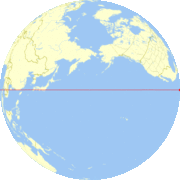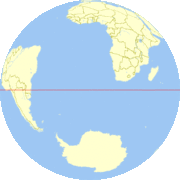Hemispheres of the Earth

Division of the Earth by the equator and prime meridian
The Hemispheres of the Earth in geography and cartography refer to any division of the globe into two hemispheres (from Ancient Greek ἡμισφαίριον hēmisphairion meaning "half of a sphere").
The most common such divisions are by latitudinal or longitudinal markers:
- North-South
- Northern Hemisphere, the half that is north of the equator
- Southern Hemisphere, the half that lies south of the equator
- East-West
- Eastern Hemisphere, the half that is east of the prime meridian and west of the 180th meridian
- Western Hemisphere, the half that lies west of the prime meridian and east of the 180th meridian
The East-West division can also be seen in a cultural sense, as a division into two cultural hemispheres.
However, other schemes have sought to divide the planet in a way that maximizes the preponderance of one geographic feature or another in each division:
- Land-Water
- Land hemisphere, the hemisphere on the Earth containing the largest possible area of land
- Water hemisphere, the hemisphere on the Earth containing the largest area of water

The land hemisphere

The water hemisphere

Land hemisphere top, water hemisphere bottom

Land hemisphere top, water hemisphere bottom
See also
References
External links
![]() Media related to Earth's hemispheres at Wikimedia Commons
Media related to Earth's hemispheres at Wikimedia Commons
| ||||||||||
This article is issued from Wikipedia - version of the Saturday, January 30, 2016. The text is available under the Creative Commons Attribution/Share Alike but additional terms may apply for the media files.